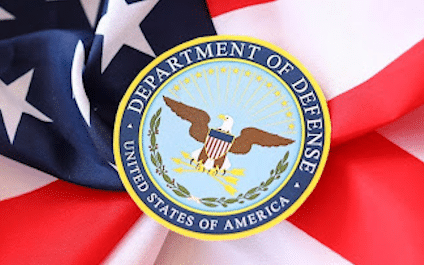The Cybersecurity Maturity Model Certification (CMMC) will soon be a universal security framework for contractors within the U.S. Department of Defense (DoD) supply chain. With CMMC designed to protect sensitive defense information, companies that fail to meet the framework’s requirements will find themselves unable to bid on or continue working on DoD contracts.
It’s not too dramatic to say that non-compliance with CMMC will serve as an existential threat to many companies. As a result, it’s vital that contractors operating in the DoD arena fully understand the complexities and challenges that CMMC presents. In this article, we’ll look at what it takes to achieve and maintain CMMC compliance, and how Kloud9—a company that’s guided numerous clients through the process (as well as navigating it ourselves)—can help.
The Costs of Non-Compliance
The most immediate and major cost of failing to meet CMMC requirements is the potential loss of DoD contracts. For businesses heavily reliant on the sector, this may result in a fundamental drop in revenue, forcing difficult decisions regarding workforce numbers and even operational viability. Beyond the direct financial impact, the inability to participate in the defense industrial base may also damage a company's reputation and long-term growth prospects.
CMMC compliance is therefore an essential part of the DoD contractor equation. That said, achieving compliance can be a complex and involved process, with the main elements involved categorized as follows:
Scoping and Gap Assessment: Identifying the discrepancies between your current security framework and the requirements of your target CMMC level is the first step. This often involves engaging expert consultants to conduct a thorough assessment. The subsequent remediation efforts, which can include implementing new security controls, updating existing infrastructure, and revising policies and procedures, can be substantial.
Technology Upgrades and Implementation: Depending on your current IT infrastructure, achieving CMMC compliance may require significant technology upgrades. This could involve investing in new hardware, software, and security tools to meet the specific technical controls outlined in the CMMC framework.
Policy and Procedure Development: CMMC places a major emphasis on documented policies and procedures. Developing and implementing comprehensive security policies, incident response plans, risk assessment plans, spillage plans, and access control procedures requires time, expertise, and careful attention to detail.
Employee Training and Awareness: Cultivating a security-aware culture within your organization is another key aspect of CMMC compliance. This requires ongoing training programs to educate employees about their roles and responsibilities in maintaining a secure environment.
Assessment Costs: The cost of the CMMC assessment itself, conducted by a Certified Third-Party Assessment Organization (C3PAO), is also a factor. These costs will vary depending on the complexity of your organization and the level of certification you’re pursuing.
Ongoing Maintenance and Monitoring: CMMC compliance is not a one-time achievement—it requires continuous monitoring, maintenance, and adaptation to evolving threats and requirements. Budgeting for ongoing security operations, updates, and potential reassessments is key to ongoing compliance.
The High Stakes of the Defense Industrial Base
Beyond the financial implications, the stakes associated with CMMC are inherently high due to the sensitive nature of the information handled within the defense industrial base. The DoD relies on its contractors to safeguard Controlled Unclassified Information (CUI) and Federal Contract Information (FCI) to protect national security. A security breach within the supply chain can have far-reaching and potentially catastrophic consequences:
Compromise of Sensitive Military Information: Unauthorized access to CUI can provide adversaries with critical insights into military technologies, strategies, and operations, potentially undermining national defense capabilities.
Disruption of Supply Chains: Cyberattacks targeting defense contractors can disrupt vital supply chains, impacting the production and delivery of essential equipment and services to the military.
Erosion of Trust: Security incidents within the defense industrial base can undermine the trust between the DoD and its contractors, potentially leading to stricter regulations and oversight.
Reputational Damage and Legal Ramifications: A failure to protect sensitive information can result in severe reputational damage, legal liabilities, and potential penalties for the affected organizations.
Needless to say, these risks are hugely profound, with CMMC designed to mitigate them by establishing a standardized and verifiable framework for cybersecurity practices across the DoD supply chain.
The CMMC Readiness Roadmap
Preparing for CMMC is no easy task. It's a complex process that requires careful planning, dedicated effort, and a thorough understanding of the requirements. For many organizations, achieving the necessary level of maturity can take upwards of a year.
A typical CMMC readiness roadmap involves the following key phases:
Scoping and Planning: This initial phase involves defining the scope of your CMMC assessment, identifying the systems and data in scope, and developing a comprehensive project plan. Understanding the specific CMMC level required for your contracts is essential at this stage.
Gap Assessment: A thorough assessment of your current cybersecurity posture against the requirements of your target CMMC level is key. This identifies the areas where your organization falls short and provides a roadmap for remediation.
Remediation: This phase involves implementing the necessary security controls, policies, and procedures to address the gaps identified in the assessment. This can be a time-consuming and resource-intensive process, requiring significant effort from your IT team and potentially external consultants.
Documentation: As mentioned, CMMC places a strong emphasis on documented policies, procedures, diagrams, lists, and processes. Developing and maintaining comprehensive documentation is critical for demonstrating compliance.
Employee Training: Educating your employees about their roles and responsibilities in maintaining a secure environment is vital, with regular security awareness training programs a key aspect of the process.
Pre-Assessment: Conducting a mock assessment can help to identify any remaining weaknesses and make sure that you are well-prepared for the official CMMC assessment.
Formal Assessment: This is the penultimate stage, where a C3PAO conducts an independent assessment to verify your compliance with the requirements of your target CMMC level.
Maintenance: The final stage is maintaining your compliance post-assessment, and performing all the necessary change controls, recurring tasks, vulnerability scans, and annual self-assessments.
The Importance of Choosing the Right Partner
Given the high stakes and costs associated with CMMC, selecting the right partner to guide you through the preparation process is of major importance. Choosing a team that lacks the necessary experience or an in-depth understanding of the CMMC framework can lead to costly delays, ineffective remediation efforts, and ultimately, failure to achieve certification.
When selecting a CMMC partner, you should consider the following factors:
Proven Experience and Success: Look for a partner with a demonstrable track record of successfully preparing other organizations for CMMC and guiding them through the assessment process. Don't hesitate to ask for references and case studies.
Firsthand Experience with CMMC: A partner who has gone through the CMMC process themselves possesses invaluable insights into the challenges and nuances of achieving compliance. At Kloud9, our own successful CMMC certification highlights our deep understanding of the requirements, and the practical steps involved.
Precise Knowledge of the CMMC Framework: Your partner should have a thorough and up-to-date understanding of the CMMC model, its various levels, and the specific controls and practices required for each.
Accredited Expertise: Make sure that your partner has qualified professionals on staff who possess relevant certifications (CMMC Certified Professionals - CCPs) and a strong understanding of cybersecurity best practices.
How Kloud9 can help
At Kloud9, we have our own CMMC Certified Professional (CCP), accredited by Cyber AB. While our in-house CCP doesn’t perform official CMMC assessments for our clients, their expertise provides us with an unparalleled understanding of the assessor's perspective and the expectations of the Cyber AB.
This internal expertise ensures that our CMMC readiness programs are carefully aligned with the latest requirements and best practices. Our CCP’s insights allow us to provide our clients with the most effective guidance and support, maximizing their chances of a successful assessment.
A Certified MSP for Ongoing Security
Maintaining CMMC compliance requires an ongoing commitment to security. As a FutureFeed certified Managed Service Provider (MSP), Kloud9 is deeply invested in providing powerful and compliant IT and security services. Our forward-thinking approach helps our clients to not only achieve CMMC certification but maintain a strong security posture in the long term.
Partnering for CMMC Success
There’s no easy path to CMMC compliance—and there probably shouldn’t be—however, a partner like Kloud9 can make the process far less overwhelming. Our firsthand experience with CMMC, deep understanding of the framework, and accredited expertise allows our clients to prepare themselves properly to meet the requirements and secure their future within the DoD supply chain.
To find out more about Kloud9 and how we can help your company achieve CMMC compliance, you can contact us www.kloud9it.com/cmmc.





